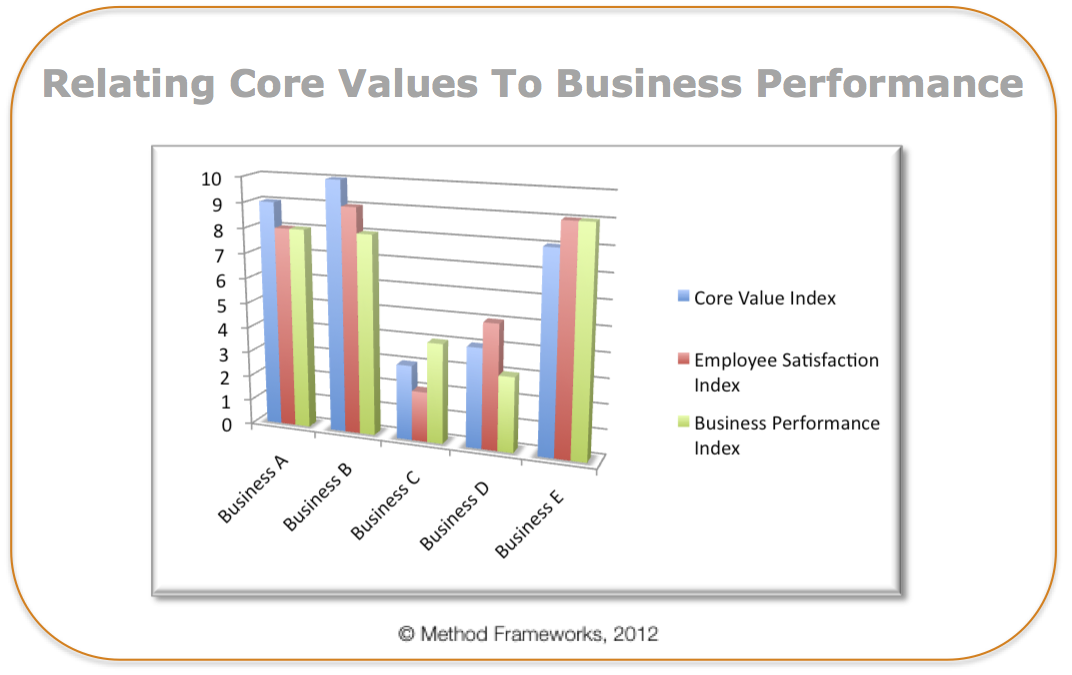Culture & Business Performance: What’s the Relationship?

 Why is it that company culture seems to be linked to the good, the bad and the ugly in today’s business world? Perhaps the answer can be found in the mounting data suggesting that businesses with strong cultures rooted in shared core values tend to have much happier employees… and happier employees help businesses be more productive. In fact, there is newly released empirical evidence from the Strategy Institute For Thought Leadership that suggests that core values (read: culture) directly correlate with business financial performance. Like it or not, business culture is indeed an integral ingredient to an improved bottom line. As such, business leaders cannot afford to look the other way and dismiss culture as some sort of “soft” or “fuzzy” element that does not have an impact on the Profit & Loss statement.
Why is it that company culture seems to be linked to the good, the bad and the ugly in today’s business world? Perhaps the answer can be found in the mounting data suggesting that businesses with strong cultures rooted in shared core values tend to have much happier employees… and happier employees help businesses be more productive. In fact, there is newly released empirical evidence from the Strategy Institute For Thought Leadership that suggests that core values (read: culture) directly correlate with business financial performance. Like it or not, business culture is indeed an integral ingredient to an improved bottom line. As such, business leaders cannot afford to look the other way and dismiss culture as some sort of “soft” or “fuzzy” element that does not have an impact on the Profit & Loss statement.
This article looks at culture from some perspectives you might not have thought about, then explores criteria to help identify business culture opportunities and how changes can be introduced to help improve performance.
What is culture in business?
In business, culture refers to the values and systems that govern how employees interact and conduct business. Some parts of culture may be formal with outlined values, ethics, and policies. Many other parts are informal. Every business has a unique corporate culture and every employee plays a part in creating it.
Why is culture important for business performance?
Research shows that organizations with performance-centric cultures experience better financial growth. One extensive study, conducted by Duke University just prior to the COVID-19 pandemic, reported that “a strong corporate culture fosters better execution, reduction in agency cost, and therefore higher productivity and creativity.” The study surveyed more than 1,800 CEOs and CFOs worldwide, and 92% of respondents reported that improved culture improves organizational value. Nearly half indicated they would not buy a business with a culture that did not align with their own. Another study, the 2018 Organizational Health Index measured by McKinsey & Company, found that organizations with healthy cultures post a return to shareholders that is 60% higher and are more likely to survive a transformational change.
A study conducted by the Strategy Institute For Thought Leadership produced findings that suggest core values and culture directly correlate with business performance. Indexed survey data from this study related to core value perceptions and employee satisfaction can be viewed relative to business financial performance – all indexed in relative terms on a scale of one to ten for five different companies.

As the graph indicates, businesses with higher core value index scores outperformed those with lower core value index scores. Likewise, employee satisfaction was noticeably higher in those same organizations.
How would your employees describe your organization’s culture?
Diagnosing a need for cultural change is among the most difficult tasks to complete in the overall job of correcting sub-par business results. By defining culture in real-life terms, it can take on a more meaningful form that allows leaders to identify cultural characteristics and better determine if problems exist, then how to go about making change if it is required.
One group that matters a great deal in learning about the organization’s culture is the employees. It is important to pick and chip through the culture puzzle by surveying employees to find out what they really think. The organization’s employees have a direct relationship with the overall experience the business provides to its customers. In high-performing cultures, employees demonstrate a clear understanding of their organization’s strategic priorities and what management values in relation to achieving strategic objectives. That aspect has major implications for performance because it is difficult for employees to be supportive of the company’s vision and strategy if they do not know what is valued as a business. Any lack of connection to strategy and “valued actions” in regard to achieving the strategic objectives is a clear indication of an opportunity for cultural correction. Employees must know what management values in order to help achieve desired results and strengthen the organization’s culture.
For example, in a software company, most employees may be focused on making better software through enhanced technical design, not on improving the end customer’s overall experience. Technical improvements, while important, will likely not be appreciated by the customer as much as a focus on the customer’s overall experience. In this example, the cultural disconnect is with a system-wide misplaced focus on the technical instead of the qualitative aspects of the software. Customers determine value on the larger overall experience, not just the software’s functions. Their perception of value is derived based on how they interact with the software and how they can get help when it is needed. Therefore, in this case, the culture is allowing for the focus to be misplaced on how the software is being built, not on improving the experience the product provides.
Identifying business culture problems through the employee’s eyes is difficult. Surveys can certainly help uncover problems, but of course, no one likes to consider themselves to be a part of the problem. “Yes, there is a problem, but it is not with my department.” Be prepared to see blame placed everywhere but where you are asking the questions.
How would customers describe your organization’s culture?
An important aspect of culture relative to business performance lies in understanding how the organization’s culture translates across to customers. Logically, the next recommendation is to find out how customers view the organization’s culture. Enthusiasm is palpable when you do business with an organization that is fanatical about making your experience the best it can be. You know that when dealing with that business, you will consistently experience that level of passion and excitement because it has become a part of the DNA of the business. It is in the culture. Such experiences are the result of a business culture that cares about the customer and understands what priorities management values the highest. Surveying customers, like employees, can be telling. In an interview with McKinsey, Bombardier CEO Pierre Beaudoin proves the point. He said, “We had an organization that was very proud of being number one and had all kinds of metrics to measure why we were very good. But when we talked to our customers, they were saying we weren’t very good.”
Not understanding your culture means not understanding how it affects your customers. Good or bad, culture represents the predominant attitude within the organization. “That’s the way we’ve always done things around here” can become a thematic tide that is hard to swim against.
What is the management culture?
While it may not be the most important factor in determining if an overall culture problem exists across the business, it is worth pointing out that there can be cultural problems at the management level and that those can be very damaging. Such problems may even be fairly benign on the surface, making them hard to spot. One such example is “happy talk”; a condition where the culture is one of avoiding putting facts on the table, accountability is ill-defined and management spends time convincing itself how good the business is doing. This goes hand-in-hand with complacency; where goals are defined in such a way that management can surpass them and feel good about its performance. Another very common cultural issue is siloing, where people are focused on their own tasks and there is very little teamwork.
In the article, A Fish Rots From the Head, it was asserted that the executive leader’s personality, traits and beliefs collectively form a signature that is stamped into the organization’s social fabric. The conduct of the organization’s leader truly sets the tone.
To illustrate through a couple of examples, let’s examine two very different companies and cultures. In one client organization, the focus of leadership was intently honed on improving financial performance, service and employee culture. Yet in the environment, many inconsistencies existed. For instance, executive-level floors had the restrooms cleaned at a ratio of 6:1 times more frequently than others in the headquarters building. This did not go unnoticed by employees on non-executive floors. The policy was intended to save dollars in facilities management costs, but it backfired. Unclean employee and public restrooms caused consternation and anger among workers, not to mention the embarrassment it caused the company as visitors witnessed the untidy conditions and complained. The misguided policy sent a signal that executives were “above” others in the company and would be treated differently. The negative impacts of the policy on employee satisfaction and a healthy culture were immense.
Conversely, in another business, the CEO moved all executives into interior offices to allow employee cubicles to get better natural lighting. In this same company, the CEO was known to help an employee carry heavy boxes containing copies of an important proposal down to the parking garage and help load them into the employee’s car. Two simple gestures, but those types of actions clearly send a very different signal to workers and have an equally strong impact on culture. The actions of the CEO said volumes, indicating, “I want you to be happy in your work, to succeed with this organization and to help us achieve our goals by being a valued member of the team, therefore I will do everything I can to help you.”
How to Introduce Changes to Business Culture
Changing an organization’s culture is a daunting feat. That’s because the culture of an organization is composed of many intricate and interconnected parts, including corporate strategy and related strategic goals, job roles, business processes, core values, communications practices, corporate attitudes and business policies. These component parts are woven together into the cultural fabric and cannot be changed in isolation. Instead, they must be addressed holistically. Below are ways changes can be made to company culture:
- Review all aspects of the business to determine points of disconnect or subpar performance
- Review the processes and attitudes in place affecting the points above
- Have leadership demonstrate new ways of approaching business
- Make organizational updates
- Explain why changes are being made and how they can positively impact the day-to-day
Consider the culture that exists in the current day environment of any organization. Just as water running for ages over rock will cut a path that channels swifter currents, culture wears its own path through the business, manifested in policies, business processes, job roles, communication practices and corporate bureaucracies. It is a part of the organization to the extent that any small attempts to introduce change will be swept away by the stronger current of institutionalized cultural rituals learned and practiced for so long. That’s not to say that culture transformation cannot be successful, only that it won’t be successful without disruption to the normal course of things. Change must be introduced to all of the elements affecting culture. There is no single action to be taken, but instead, an orchestrated regimen of small and large steps will help break the rut and allow new flows to open.
Aiming for performance excellence through business culture
Culture does affect performance, therefore the goal of tampering with culture in the first place is to influence the organizational ethos towards one of performance and excellence. Most executives would submit that we want the associates in our business, among other things, to be:
- highly ethical
- focused on creating value for our customers,
- conscientious about avoiding waste,
- dedicated to providing fanatical customer service,
- involved, responsible and giving citizens in the communities where they live.
Corporate leaders must model this behavior themselves. If cultural change is sought, executives must do more than talk the talk…they must also walk the walk.
In addition to leadership committing to championing culture change, many areas of the business likely will face makeovers – such as job role changes, business processes that must be altered or realigned and communications practices that must be improved to help cultural change take hold. Based on organizational model changes and related process impacts — communication will be affected, as well as decision processes and process latency expansions or constrictions. These must be well understood, expected and planned. Most importantly, employees will be impacted by the change. Communicate the goals of change to employees and include them in the process by connecting goals to each person’s day-to-day work.
Lastly, expect that changes will be disruptive. The good news is that disruption will help the business break free from the well-worn patterns that currently hold it in place and increase the speed of transition to the future-state culture.
***
Related Resources
Culture & Business Performance: What’s the Relationship?
Complimentary Strategic Planning Article Compilations and PDFs:
Strategic Planning Monthly Archive
Strategic Planning Articles Library
 – Complimentary access: Strategic Planning White Paper PDF Downloads
– Complimentary access: Strategic Planning White Paper PDF Downloads
Category: Business Growth & Strategy
Tags: Culture, Management, Strategy




Interesting, certainly something I might not HAVE thought about?
Thank you for the comment.
I like the term “happy talk.” This is a culture of delusional leadership; living in the bubble, avoiding, or not even knowing how to develop and execute an effective strategic plan.